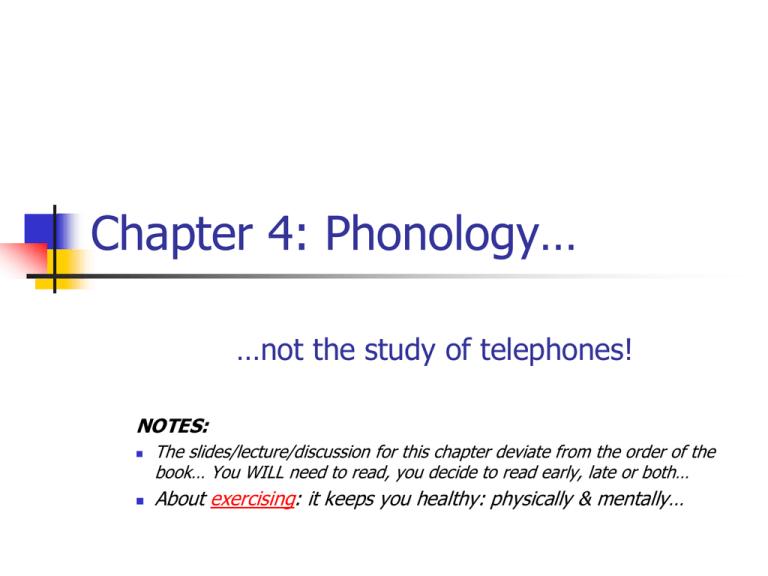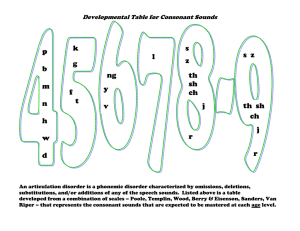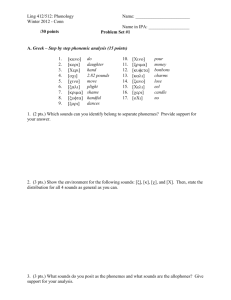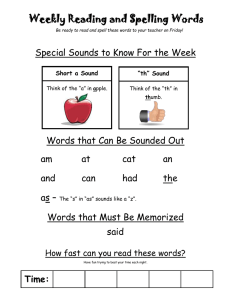Chapter 4: Slides
advertisement

Chapter 4: Phonology… …not the study of telephones! NOTES: The slides/lecture/discussion for this chapter deviate from the order of the book… You WILL need to read, you decide to read early, late or both… About exercising: it keeps you healthy: physically & mentally… Kinds of Sound Change Assimilation Nasalization Voicing Flapping Dissimilation (become more alike) Metathesis Epenthesis // Intrusion (become less alike) (shift sounds around) (add a sound) Other Elision // Deletion Vowel Reduction (take a sound away) (shorten or ‘schwa’ a sound) Kinds of Sound Change Sound Safari Find example words for one subcategory of each type of sound change in the previous slide Hand me the examples highlighting IPA for “careful” vs. “fast-casual” speech Explanation of the change in terms of natural classes Answer: Is the created sound always allophonic, or sometimes phonemic Phonemes Formal Definition: Sounds that are heard distinctively by native speakers of a language Dave’s Translation: Sound that make meaningful differences in a language What word do you get… …if you delete the first sound of: 1. 2. 3. 4. Do sounds 1, 2, 3, &/or 4 test for phonological awareness? On Being Distinctive AKA Contrastive … AKA Phonemic Minimal pairs You tell me: Standard spelling for each of the above… More minimal pairs… What’s This? Allophones Formal Definition: Sounds that are NOT heard distinctively by native speakers of a language Dave’s Translation: Sounds that DO NOT make meaningful differences in a language Aspiration Hold a paper in front of your mouth Say “pot” and “poke” Then “spot” and “spoke” Does the paper move differently? Phonemes & Allophones Minimal Pairs phonemic distinction - Allophones (in English) (sit, sing) Phonetically distinct, phonologically same Complementary distribution Other Language: Phonemic or allophonic? Phonological Principles Ideal vs. Realization Largely subconscious Universals exist Rule governed Rules can be formalized Rules can be generalized Rules must be ordered… To Formalize Phoneme –Allophone Illustration Underlying form Surface form Phonological Rule Explain the Rule… What type of change is this? In Simpler Words A B / C __ D A becomes B when it comes between C and C We typically use features for A, B, C and D… For shorthand we may sometimes use segments instead… Rules & Allophones Get Some Exercise Yes, [h] and [?] are phonemic. Both appear at the beginning & between vowels… Any Questions… …before we move on? (…breathe, stretch, move around…) Natural Classes Sounds that share feature(s) and behave similarly in phonology Consonants + Stop + Voice - Stop - Voice Vowels + High + Back - High - Back Natural Classes: Exercise Natural Classes: Answers Challenge: Find the rest… (there are at least 12) Get Some Exercise More Exercise… Any Questions… …before we move on? Phonological Units Features The atoms of phonology Building blocks of sound Key to understanding (most) variation Binary distinction (+/-) You’ve either got it, or you don’t… Any Questions… …before we move on? Possible English Words? Syllable Book’s Definition: A unit of linguistic structure that consists of a syllabic element and any segments that are associated with it Dave’s Interpretation: A potentially independent group of sounds that sticks closely together Syllabic Recipe sprint σ Onset (O) Rhyme (R) Nucleus (N) Coda (Co) NOTE: Only the Nucleus is required… Sequence Constraints (Phonotactic Constraints) Formal Definition: The set of constraints on how sequences of segments pattern Dave’s Interpretation: Rules on which sounds can be next to each other (≈ in a syllable) Sequence Constraints Different languages = Different rules English V, VC, CV, CVC, CCV, etc… ≠ Spanish ≠ Onset = [sk], [st], [sp] Japanese ≠ “C” as coda, except [n] Explain Spanish or Japanese constraints in terms of natural classes… Whaddya Know… … about syllable constraints in another language? Don’t Get Stressed Out… Primary and Secondary Stress Separate Words Whíte hóuse Single Concept = Separate Stress = Related Stress Whíte Hòuse Multi-syllable words Stress varies http://oak.ucc.nau.edu/tn24/wordstress/wstresstext.html Syllablabic Interventions… Sentence Level Stress Stress Content Words N, V, Adj, Adv Not function words Det, Aux Vs, Conj’s, Pronouns, Prepositions Any Questions… …before we move on? Try It: The Plural Suffix Orthography: -s or -es Phonetic: Sort the following phonetically: tack, tag, torch, cough, cup, dish, dress, grave, graph, hat, house, hunch, judge, lad, lash, lathe, maze, room, tax, thing Why? (i.e. What are the rules?) tack cough cup graph hat tag grave lad lathe room thing torch dish dress house hunch judge lash maze tax 3 Rules Plural Rules: Any Questions… …before we move on? …only two slides left… Cross-linguistic Variation For “Tomorrow” Quiz Exercises Yes, they’re a good idea… 4-1, 4, 8, 15 Teacher-focused, but also good: 4-18, 19, 20, 22







